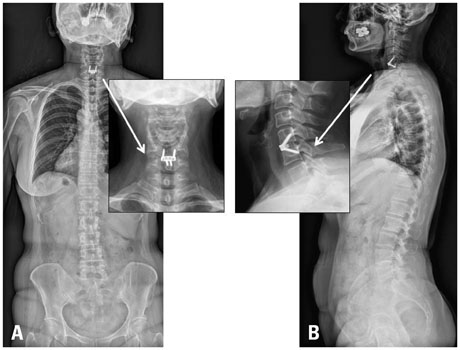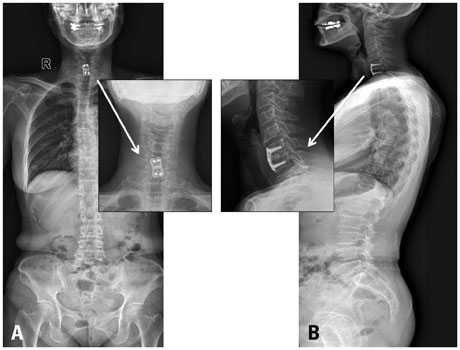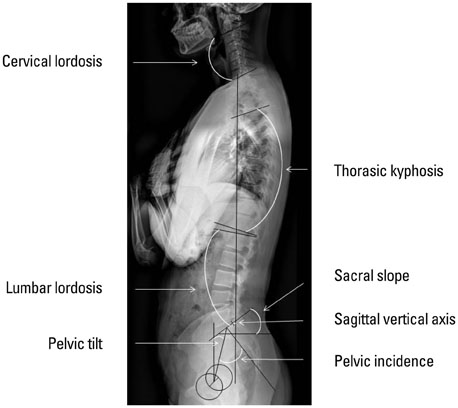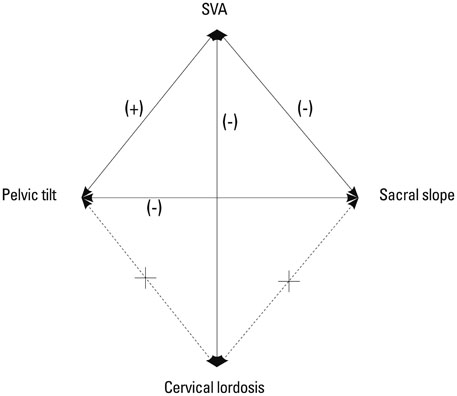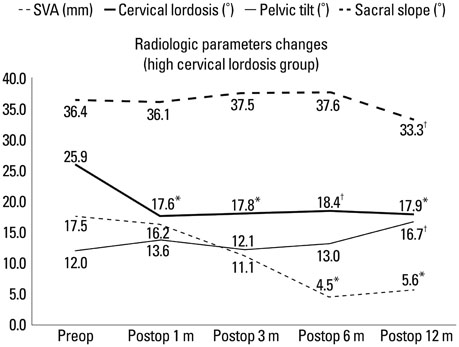Yonsei Med J.
2015 Jul;56(4):1060-1070. 10.3349/ymj.2015.56.4.1060.
Anterior Cervical Discectomy and Fusion Alters Whole-Spine Sagittal Alignment
- Affiliations
-
- 1Department of Neurosurgery, Gangnam Severance Hospital, Spine and Spinal Cord Institute, Yonsei University College of Medicine, Seoul, Korea. spinepjy@yuhs.ac
- 2Department of Neurosurgery, Severance Hospital, Yonsei University College of Medicine, Seoul, Korea.
- KMID: 2366349
- DOI: http://doi.org/10.3349/ymj.2015.56.4.1060
Abstract
- PURPOSE
Anterior cervical discectomy and fusion (ACDF) has become a common spine procedure, however, there have been no previous studies on whole spine alignment changes after cervical fusion. Our purpose in this study was to determine whole spine sagittal alignment and pelvic alignment changes after ACDF.
MATERIALS AND METHODS
Forty-eight patients who had undergone ACDF from January 2011 to December 2012 were enrolled in this study. Cervical lordosis, thoracic kyphosis, lumbar lordosis, sagittal vertical axis (SVA), and pelvic parameters were measured preoperatively and at 1, 3, 6, and 12 months postoperatively. Clinical outcomes were assessed using Visual Analog Scale (VAS) scores and Neck Disability Index (NDI) values.
RESULTS
Forty-eight patients were grouped according to operative method (cage only, cage & plate), operative level (upper level: C3/4 & C4/5; lower level: C5/6 & C6/7), and cervical lordosis (high lordosis, low lordosis). All patients experienced significant improvements in VAS scores and NDI values after surgery. Among the radiologic parameters, pelvic tilt increased and sacral slope decreased at 12 months postoperatively. Only the high cervical lordosis group showed significantly-decreased cervical lordosis and a shortened SVA postoperatively. Correlation tests revealed that cervical lordosis was significantly correlated with SVA and that SVA was significantly correlated with pelvic tilt and sacral slope.
CONCLUSION
ACDF affects whole spine sagittal alignment, especially in patients with high cervical lordosis. In these patients, alteration of cervical lordosis to a normal angle shortened the SVA and resulted in reciprocal changes in pelvic tilt and sacral slope.
MeSH Terms
-
Adult
Aged
Cervical Vertebrae/physiopathology/radiography/*surgery
Cross-Sectional Studies
*Diskectomy
Female
Humans
Lordosis/etiology/*surgery
Magnetic Resonance Imaging
Male
Middle Aged
Neck/surgery
Retrospective Studies
Spinal Diseases/complications/physiopathology/radiography/*surgery
Spinal Fusion/*methods
Spine
Treatment Outcome
Young Adult
Figure
Cited by 2 articles
-
The Influences of Different Ratios of Biphasic Calcium Phosphate and Collagen Augmentation on Posterior Lumbar Spinal Fusion in Rat Model
Kyung-Hyun Kim, Jeong-Yoon Park, Hyo-Suk Park, Keun-Su Kim, Dong-Kyu Chin, Yong-Eun Cho, Sung-Uk Kuh
Yonsei Med J. 2017;58(2):407-414. doi: 10.3349/ymj.2017.58.2.407.Analyzing the Significance of T1 Slope minus Cervical Lordosis in Patients with Anterior Cervical Discectomy and Fusion Surgery
Ho Jin Lee, Soon Tae You, Jae Hoon Sung, Il Sup Kim, Jae Taek Hong
J Korean Neurosurg Soc. 2021;64(6):913-921. doi: 10.3340/jkns.2021.0011.
Reference
-
1. Ha Y, Schwab F, Lafage V, Mundis G, Shaffrey C, Smith J, et al. Reciprocal changes in cervical spine alignment after corrective thoracolumbar deformity surgery. Eur Spine J. 2014; 23:552–559.
Article2. Schwab F, Lafage V, Boyce R, Skalli W, Farcy JP. Gravity line analysis in adult volunteers: age-related correlation with spinal parameters, pelvic parameters, and foot position. Spine (Phila Pa 1976). 2006; 31:E959–E967.3. Vialle R, Levassor N, Rillardon L, Templier A, Skalli W, Guigui P. Radiographic analysis of the sagittal alignment and balance of the spine in asymptomatic subjects. J Bone Joint Surg Am. 2005; 87:260–267.
Article4. Boulay C, Tardieu C, Hecquet J, Benaim C, Mouilleseaux B, Marty C, et al. Sagittal alignment of spine and pelvis regulated by pelvic incidence: standard values and prediction of lordosis. Eur Spine J. 2006; 15:415–422.
Article5. Le Huec JC, Aunoble S, Philippe L, Nicolas P. Pelvic parameters: origin and significance. Eur Spine J. 2011; 20:Suppl 5. 564–571.
Article6. Scheer JK, Tang JA, Smith JS, Acosta FL Jr, Protopsaltis TS, Blondel B, et al. Cervical spine alignment, sagittal deformity, and clinical implications: a review. J Neurosurg Spine. 2013; 19:141–159.7. Cil A, Yazici M, Uzumcugil A, Kandemir U, Alanay A, Alanay Y, et al. The evolution of sagittal segmental alignment of the spine during childhood. Spine (Phila Pa 1976). 2005; 30:93–100.
Article8. Smith JS, Shaffrey CI, Lafage V, Blondel B, Schwab F, Hostin R, et al. Spontaneous improvement of cervical alignment after correction of global sagittal balance following pedicle subtraction osteotomy. J Neurosurg Spine. 2012; 17:300–307.
Article9. Lee SH, Son ES, Seo EM, Suk KS, Kim KT. Factors determining cervical spine sagittal balance in asymptomatic adults: correlation with spinopelvic balance and thoracic inlet alignment. Spine J. 2015; 15:705–712.
Article10. Smith GW, Robinson RA. The treatment of certain cervical-spine disorders by anterior removal of the intervertebral disc and interbody fusion. J Bone Joint Surg Am. 1958; 40-A:607–624.
Article11. Park SB, Jahng TA, Chung CK. Remodeling of adjacent spinal alignments following cervical arthroplasty and anterior discectomy and fusion. Eur Spine J. 2012; 21:322–327.
Article12. Kaiser MG, Haid RW Jr, Subach BR, Barnes B, Rodts GE Jr. Anterior cervical plating enhances arthrodesis after discectomy and fusion with cortical allograft. Neurosurgery. 2002; 50:229–236.
Article13. Xie JC, Hurlbert RJ. Discectomy versus discectomy with fusion versus discectomy with fusion and instrumentation: a prospective randomized study. Neurosurgery. 2007; 61:107–116.14. Lee JY, Park MS, Moon SH, Shin JH, Kim SW, Kim YC, et al. Loss of lordosis and clinical outcomes after anterior cervical fusion with dynamic rotational plates. Yonsei Med J. 2013; 54:726–731.
Article15. Miao J, Shen Y, Kuang Y, Yang L, Wang X, Chen Y, et al. Early follow-up outcomes of a new zero-profile implant used in anterior cervical discectomy and fusion. J Spinal Disord Tech. 2013; 26:E193–E197.
Article16. Miller LE, Block JE. Safety and effectiveness of bone allografts in anterior cervical discectomy and fusion surgery. Spine (Phila Pa 1976). 2011; 36:2045–2050.
Article17. Vrtovec T, Janssen MM, Likar B, Castelein RM, Viergever MA, Pernusš F. A review of methods for evaluating the quantitative parameters of sagittal pelvic alignment. Spine J. 2012; 12:433–446.
Article18. Gardocki RJ, Watkins RG, Williams LA. Measurements of lumbopelvic lordosis using the pelvic radius technique as it correlates with sagittal spinal balance and sacral translation. Spine J. 2002; 2:421–429.
Article19. Morvan G, Mathieu P, Vuillemin V, Guerini H, Bossard P, Zeitoun F, et al. Standardized way for imaging of the sagittal spinal balance. Eur Spine J. 2011; 20:Suppl 5. 602–608.
Article20. Roussouly P, Nnadi C. Sagittal plane deformity: an overview of interpretation and management. Eur Spine J. 2010; 19:1824–1836.
Article21. Blondel B, Lafage V, Schwab F, Farcy JP, Bollini G, Jouve JL. Reciprocal sagittal alignment changes after posterior fusion in the setting of adolescent idiopathic scoliosis. Eur Spine J. 2012; 21:1964–1971.
Article22. Ilharreborde B, Vidal C, Skalli W, Mazda K. Sagittal alignment of the cervical spine in adolescent idiopathic scoliosis treated by posteromedial translation. Eur Spine J. 2013; 22:330–337.
Article23. Kim KT, Suk KS, Cho YJ, Hong GP, Park BJ. Clinical outcome results of pedicle subtraction osteotomy in ankylosing spondylitis with kyphotic deformity. Spine (Phila Pa 1976). 2002; 27:612–618.
Article24. Kim YJ, Bridwell KH, Lenke LG, Rhim S, Cheh G. An analysis of sagittal spinal alignment following long adult lumbar instrumentation and fusion to L5 or S1: can we predict ideal lumbar lordosis? Spine (Phila Pa 1976). 2006; 31:2343–2352.
Article25. Lafage V, Schwab F, Vira S, Patel A, Ungar B, Farcy JP. Spino-pelvic parameters after surgery can be predicted: a preliminary formula and validation of standing alignment. Spine (Phila Pa 1976). 2011; 36:1037–1045.26. Lafage V, Blondel B, Schwab F, Ames CP, LeHuec JC, Smith JS, et al. The crucial role of cervical alignment in regulating sagittal spino-pelvic alignment in human standing posture. In : Presented at the 19th International Meeting on Advanced Spine Techniques; July 18-21, 2012; Istanbul Turkey. 2012.
- Full Text Links
- Actions
-
Cited
- CITED
-
- Close
- Share
- Similar articles
-
- Anterior Cervical Discectomy
- Cervical Sagittal Alignment: Literature Review and Future Directions
- The Sagittal Balance of Cervical Spine : Comprehensive Review of Recent Update
- The Efficacy of the Unicortical Screw in the Anterior Cervical Fusion of the Degenerative Cervical Spine Disease
- A Review of Finite Element Modeling for Anterior Cervical Discectomy and Fusion

